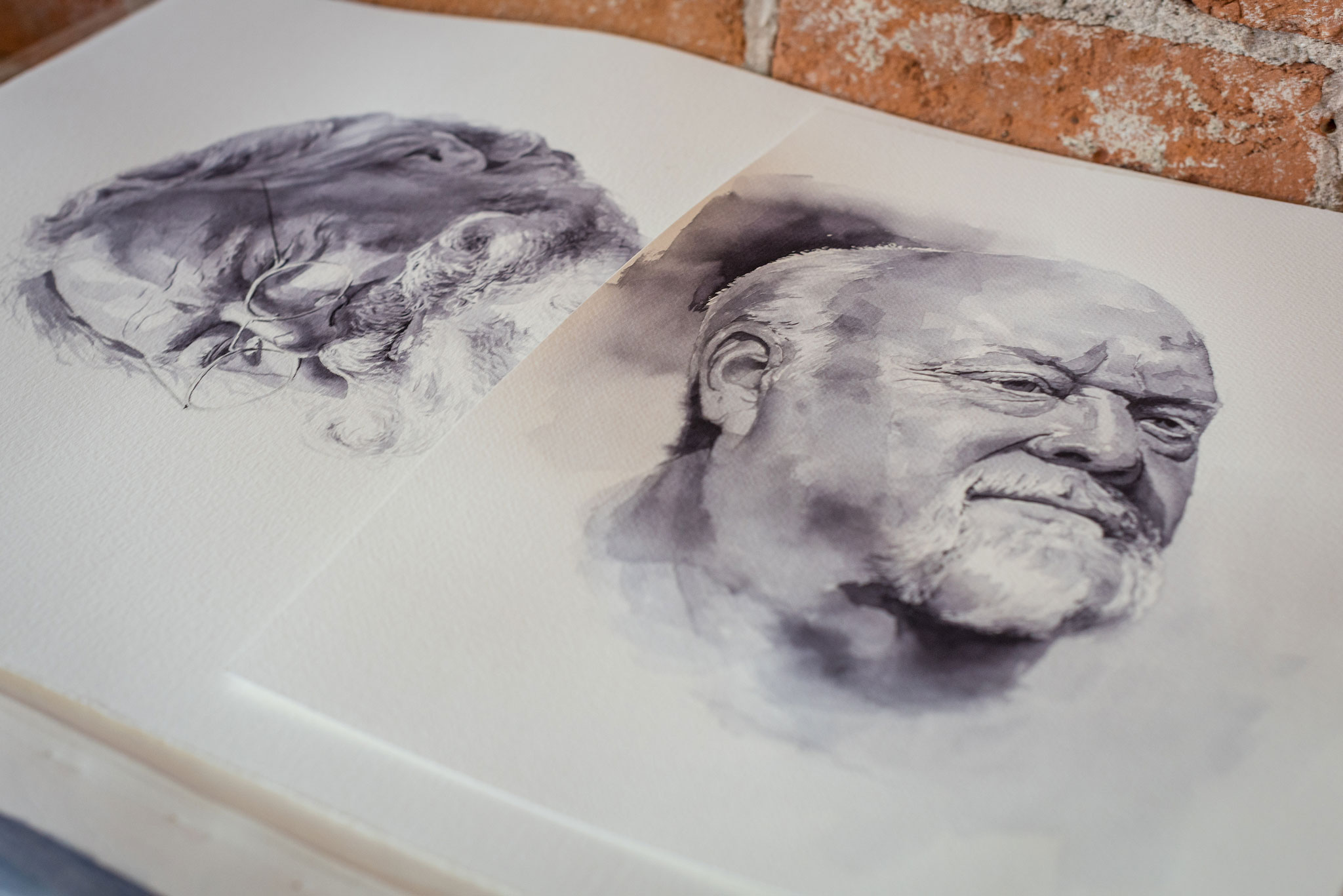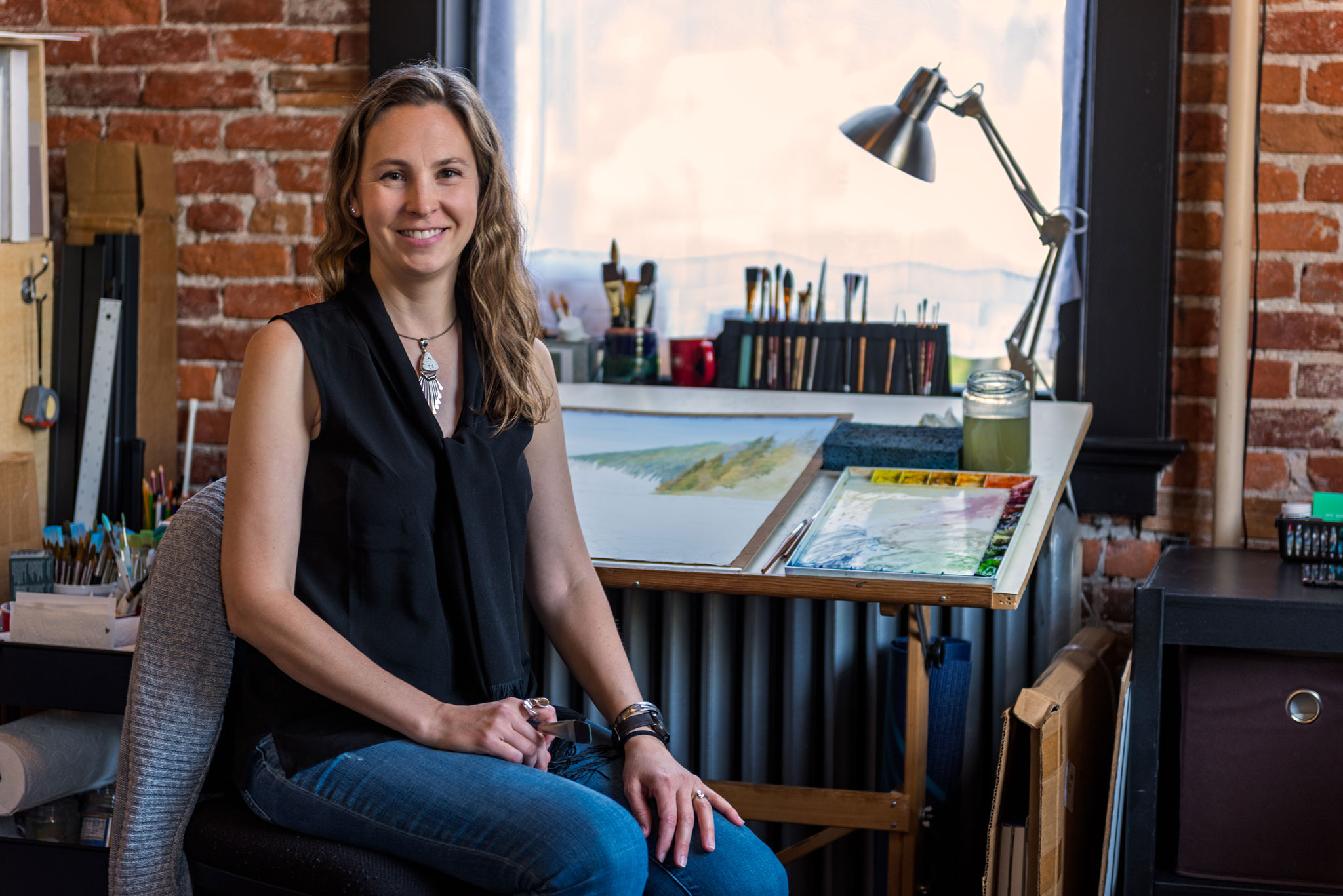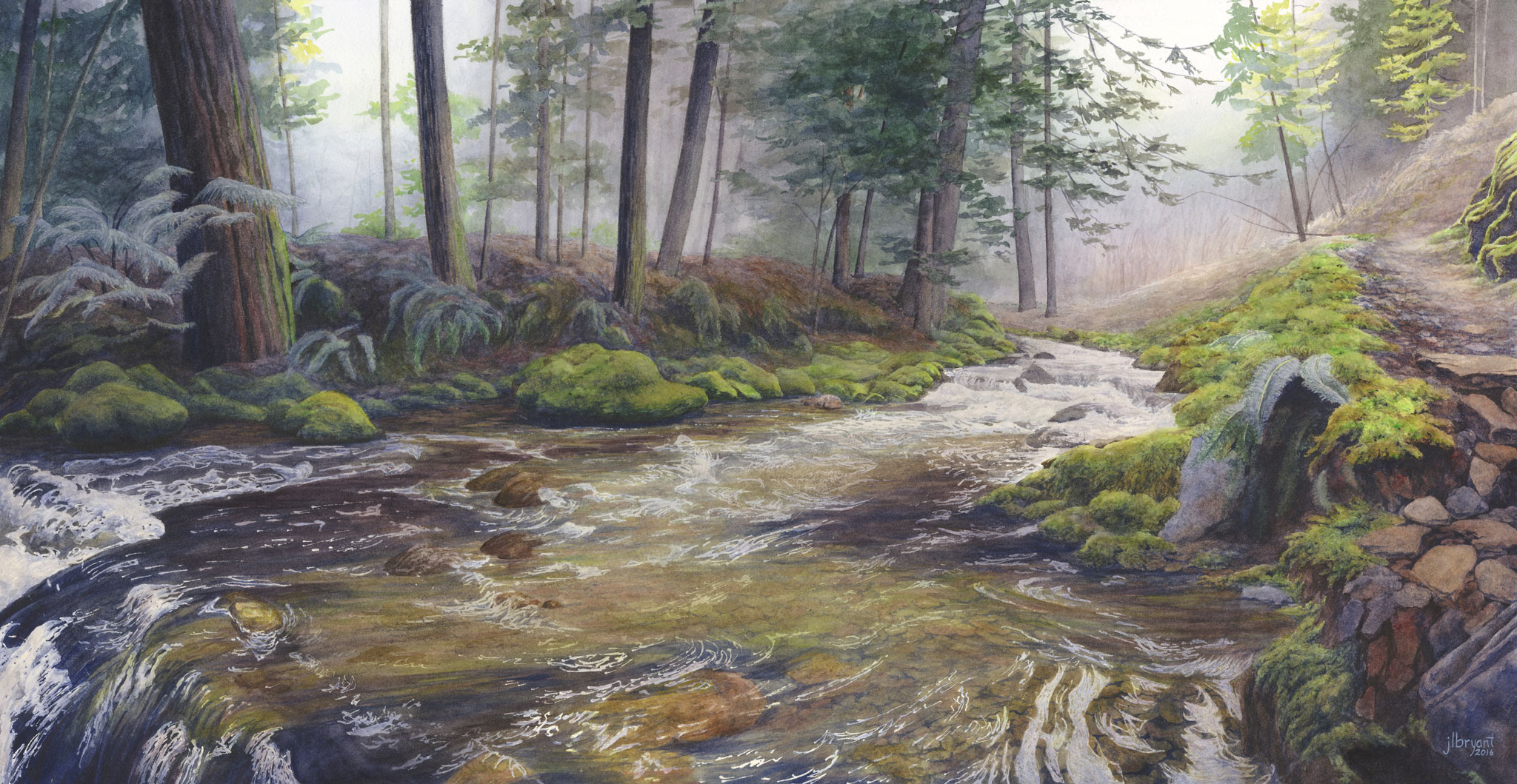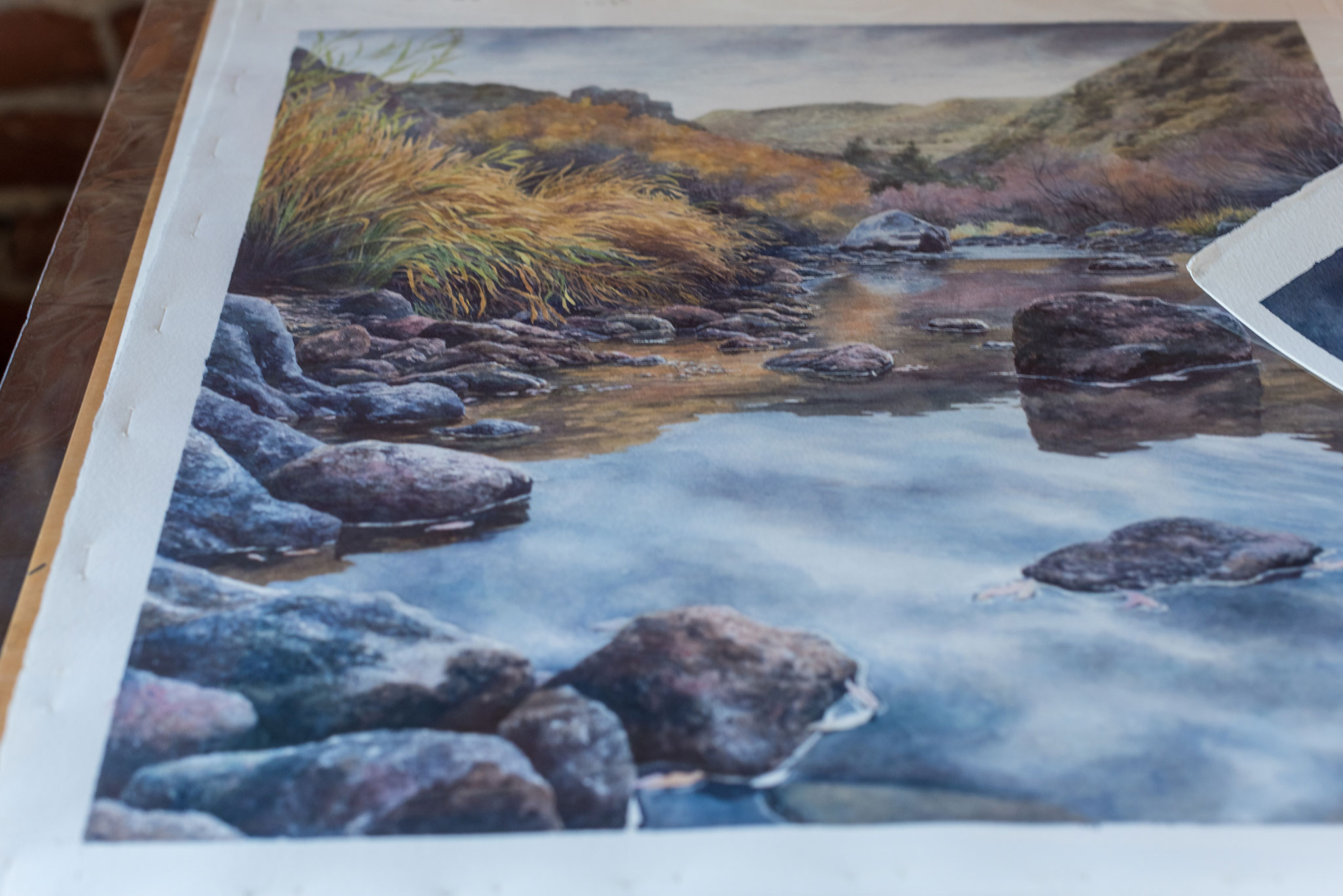Traveling the Badlands alone is not a good idea. The South Dakota National Park is home to rattlesnakes, unstable hiking grounds, high heat, tornadoes and dangerous windstorms. The expanses of the Badlands have even sent a few hikers missing.
But Jesica isn’t here for the thrill of danger.
She is here for the contrast of the green grasses with the pinks and purples of the setting sun. She is here for the dry grasses that hug the base of jagged rock formations, erosion giving way to different layers of yellow, red, brown and white rock. She is here to paint.
Remote roads away from the nearest town, she explores the environment before dipping her brush into a glass of water and beginning to paint.
Jessica Bryant is a wilderness watercolor artist and signature member of the Northwest Watercolor Society. She has also exhibited with the renowned American Watercolor Society founded in 1866.

Celebrating her 11th year in watercolor, her work has been featured in numerous national exhibits, including the U.S. Botanical Gardens in Washington, D.C., the historic Salmagundi Art Club in New York and the Google Cultural Institute. Jessica said creating art has been essential to her happiness and growth.
“My entire childhood was an arts education,” she said. “My dad taught me the foundations of art — how first to see a scene and then how to draw it.”
But Jessica never considered a career in art, especially a career in watercolor. That is until she found herself living in California to support her husband and search for her own sense of fulfillment.
Living in the Silicon Valley with her husband, a successful software engineer, and two young children, Jessica felt the need for an artistic outlet.
The recent University of Minnesota graduate, who took American Studies to understand people and cultures, found herself missing the art and music of her childhood.
On a whim, she registered for a watercolor class. She had painted watercolor in high school and even won a congressional district art show. Her painting traveled to Washington, D.C. where it was on display for a year. She hated it then but not now. She was a natural. It was as if she had never put down her brush.
“I emailed my dad a photo of my first painting and told him I thought I could likely paint professionally,” she said. “He agreed. He knew I had a natural tendency for art. Pretty soon, I was thinking, ‘If I really tried, I could be good at this.’”
Jessica painted any free moment she had. She painted while her oldest son was at school, during nap times and even late at night while her family was asleep. Painting was her form of meditating.
Story continues after a quick message from our sponsor below.
She learned about positive and negative space and how gravity could be a friend and an enemy. Painting felt more like a science. She had to care about the surface tension of water. She had to calculate how different sizes of water bubbles interact with paint as water evaporates. She even learned that sometimes a toothbrush works just as well as a paint brush.
“Watercolor is transparent,” she said. “You see every layer, every timid brush stroke. You have to commit to every color. You have to attach yourself to the art.”

Passionate about nature and wilderness, Jessica was drawn to painting the nature around her.
While on a hike in the Grand Canyon, Jessica stumbled on an Artist in Residence gallery. She learned many national parks and nonprofit organizations offered stipends to artists to pursue their discipline while curating shows, teaching workshops or simply putting their art on display. This was a perfect opportunity to be exposed to different environments, find more scenes to paint, and have the chance to live in a national park for a prolonged stay.
She applied and was accepted into an artist residency in the Badlands and, later, Rocky Mountain National Park in Colorado. She would stay in the William Allen White Cabin where 10 U.S. Presidents have stayed before.
“When I got there, I was elated,” she said. “I had visited Rocky Mountain in college, and fell in love. It was my first national park experience, and so it was a thrill to return as Artist in Residence during the park’s 150th year.”
Through trial and error, she developed the best way to paint the scenery around her. Lugging her paper, water jugs, paints and brushes across the vast Colorado landscape was just not plausible. Plus, each painting took around 60 to 80 hours to complete, and by then the sun had moved and leaves had blown away. Photography being a long-time hobby, she loaded a professional digital camera in her backpack and focused on experiencing the location in order to better represent it on paper.
The colors, the smells, the lighting, the mood of the clouds — all of it didn’t look the same on the camera screen. A picture just wasn’t enough. She learned to memorize the trees and mountains around her. She had to pick what details she would keep versus eliminate to make the scene “true to the experience of being there.”
She had to recall the way she felt when she first stepped into the park.
To relive the scene, Jessica would trek back to the cabin and put on music to create “the same mood as the experience of the hike.” Her watercolor paintings were faithful translations.

“People would see my paintings and say, ‘That’s just what it feels like to be there!’” she said. The paints she hated as a high schooler came together to create highly detailed and lifelike scenes.
Watercolor was second nature.
After a brief stay in California, Jessica and her family moved back to Coeur d’Alene, happy to return home. She entered work into Art on the Green, which she has done every year since, and found a community for her art.
She accepted artist residencies with Joshua Tree National Park in California, Badlands National Park in South Dakota, Rocky Mountain National Park in Colorado, and the Western Arctic National Parklands. Completely isolated in the Arctic Circle, she journeyed into the backcountry by float and bush planes to explore on foot. She has also been an Artist in Residence for the Owyhee Canyonlands Wilderness Area in Southwest Idaho, and is the current Artist in Residence for the Idaho Conservation League.
Jessica has won many nationally recognized awards and has been honored in prestigious watercolor groups. She was even invited to give a TED Talk. But, really, Jessica cares most about advancing her skills, public outreach, and making art and nature accessible to everyone.
A co-founder of Redbrick Art Studio in downtown Coeur d’Alene, Jessica teaches classes and hosts art summer camps for people of all ages. She is also the director of the Fine Arts League, an extracurricular art class at Sorensen Magnet School. At both places, Jessica wants to teach budding artists the foundational skills that allow individuals the freedom to create the work they want in their own style.
“Paint what you love, in the style you love, and don’t agonize,” she said.
“Why you paint the way you do is who you are.”
“My goal is to enable students to develop the skills they need to paint how they want.”
As the Artist in Residence for the Idaho Conservation League, her next goal is to paint the rivers of Idaho during the 50th anniversary of the Senator Frank Church’s Wild and Scenic Rivers Act.
She also wouldn’t mind heading out on the road for another adventure.
“Places, landscapes, become friends,” she said. “I have many dear friends, and there’s always room for more.” N
By Rosemary Anderson
Photography By Joel Riner
As Featured In: 2019 Winter/Spring CDA Edition




